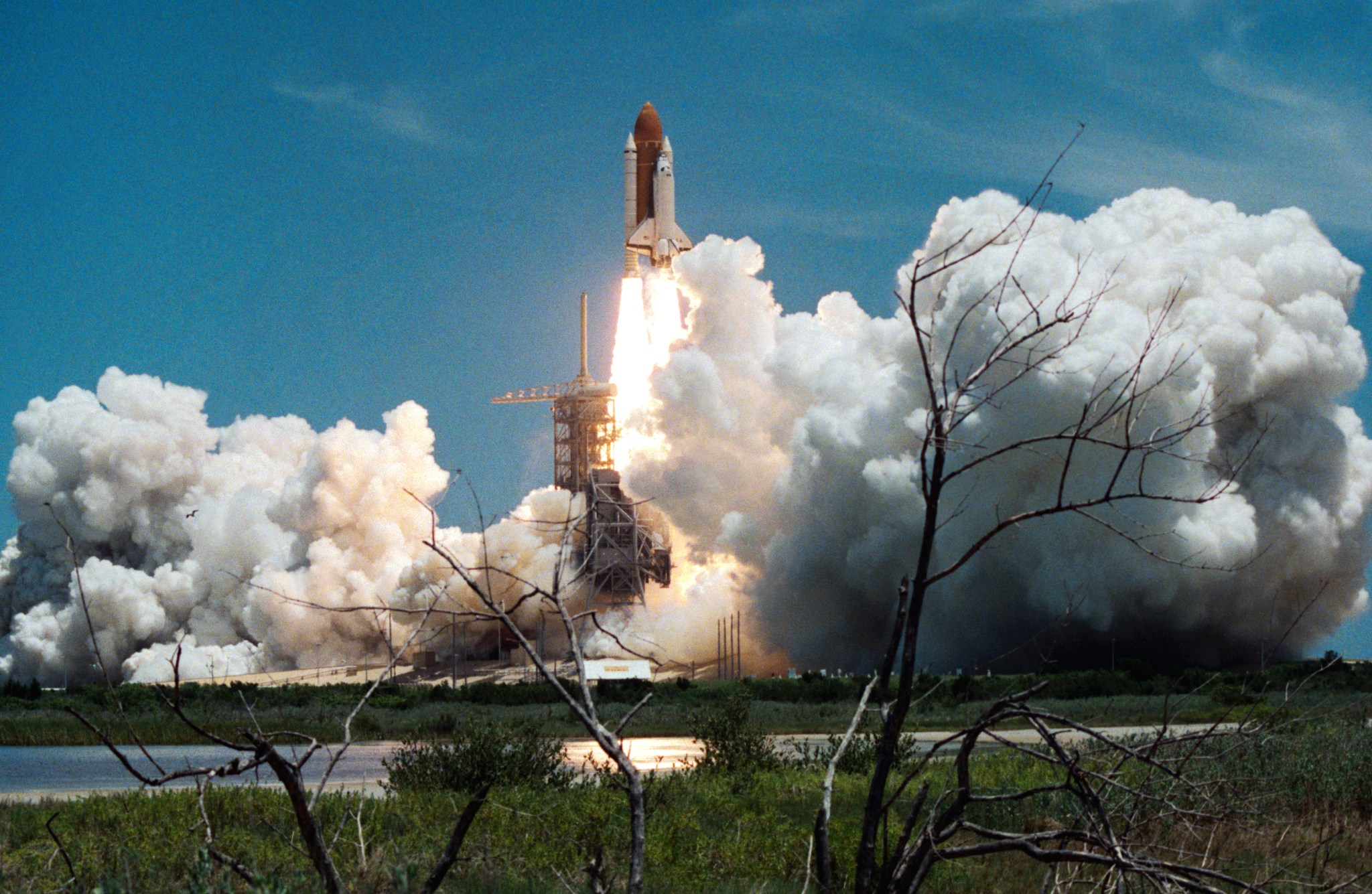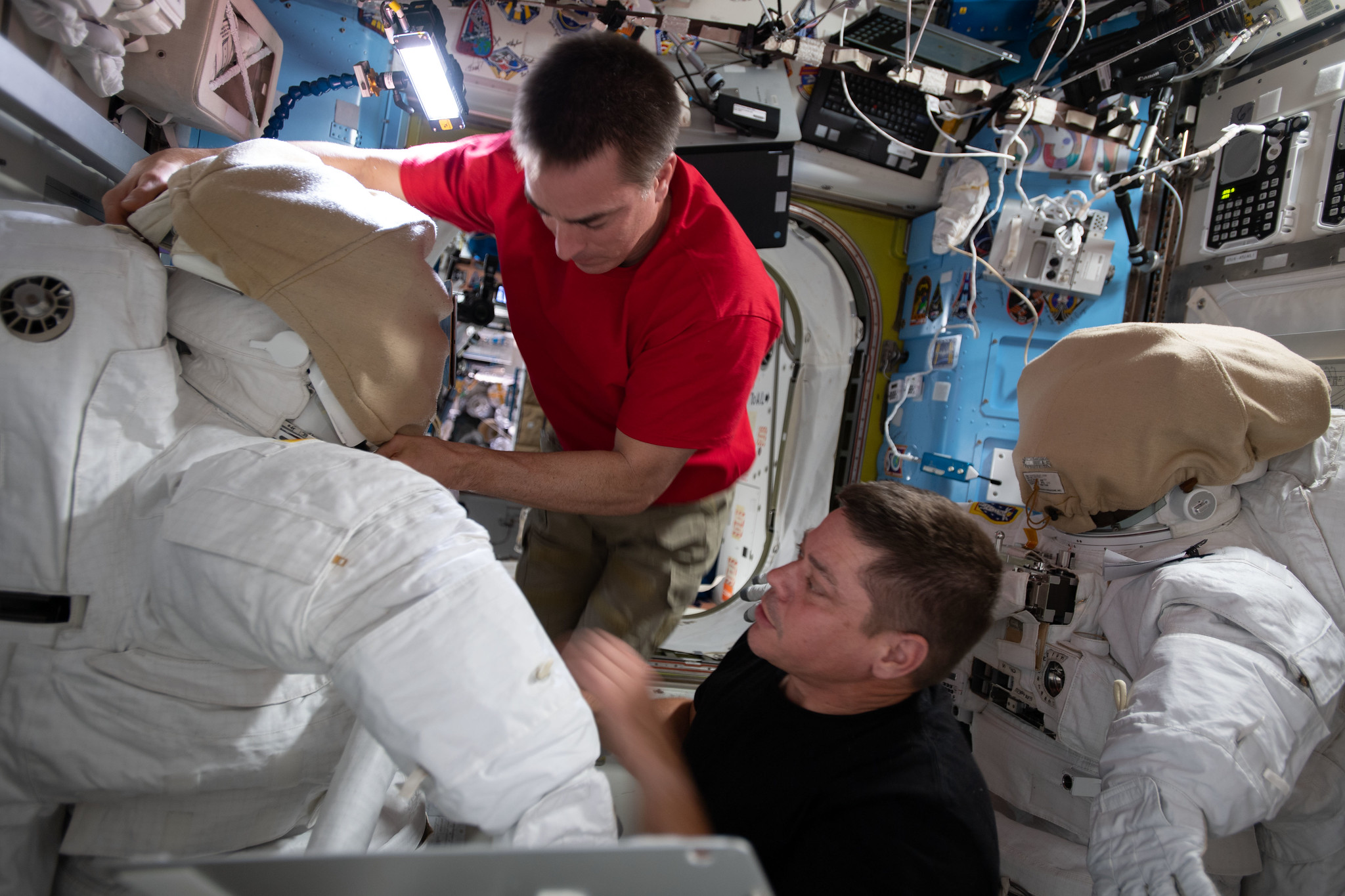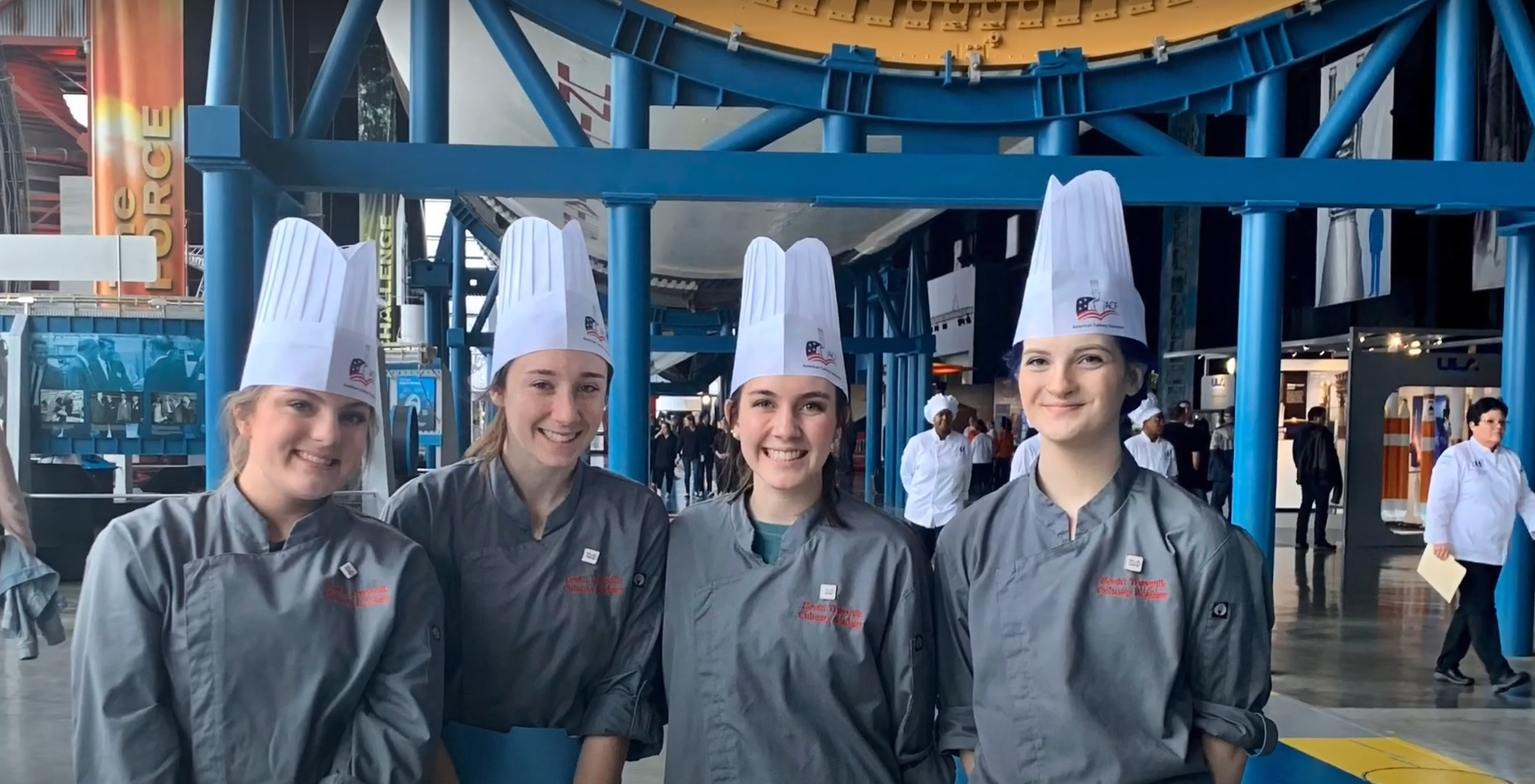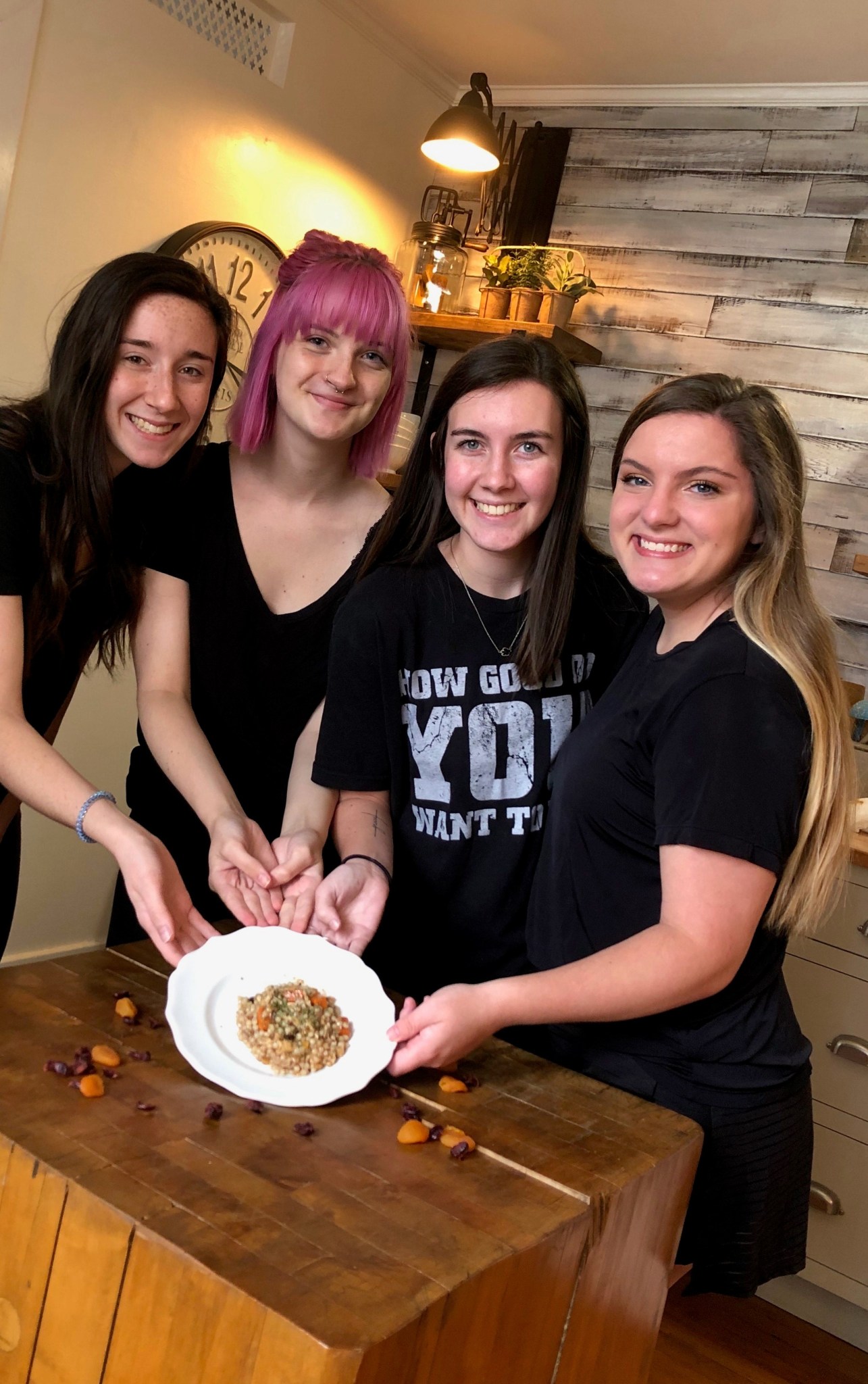In This Week’s Star
- Space Station Crew Conduct Landmark Spacewalks
- NASA Completes Structural Test Campaign for SLS Rocket
- Marshall Assembles Artemis II Orion Stage Adapter
- Alabama High School Wins HUNCH Culinary Competition
- Rocket Science in 60 Seconds: What Is NASA’s Rocket Train?
- Feds Feed Families Coordinator: Annual Drive Honors Legacy of Giving by Individuals, Marshall Team
- Chandra Helps Showcase Galactic Virtual Reality Adventure
- This Week in NASA History: Second International Microgravity Laboratory Launches – July 8, 1994
Space Station Crew Conduct Landmark Spacewalks
On June 26 and July 1, NASA astronauts Chris Cassidy and Bob Behnken conducted a pair of extended spacewalks outside the International Space Station to replace the orbital science facility’s aging batteries and route cable along the station’s spine-like truss structure.
The July 1 spacewalk, available to watch in its entirety here, lasted six hours and one minute. During the excursion, Cassidy and Behnken routed power and Ethernet cables to prepare to equip the station with a new external wireless communications system – including an enhanced, high-definition camera and increased helmet camera coverage for future spacewalks.
They also successfully continued work to upgrade batteries that power portions of the station’s enormous solar arrays. An ongoing effort since 2017, the battery replacement project is expected to provide improved power capacity for a variety of in-orbit operations. It will be completed during two dedicated spacewalks later in July, which will be scheduled once NASA has assessed the station’s upgraded power status.
During the June 26 spacewalk, which lasted six hours and seven minutes and can be viewed here, Cassidy and Behnken kicked off the final round of solar array power upgrades. They installed new lithium-ion batteries and adapters, which arrived on the station in early June via a Japanese cargo flight.
The batteries store power generated by the station’s solar arrays to provide power to the science labs and experiments – aided and overseen by Payload Operations Integration Center personnel at NASA’s Marshall Space Flight Center – even when the station is out of direct sunlight, circling behind Earth during orbital night.
The latest spacewalk on July 1 marked the eighth excursion each for Cassidy and Behnken. Cassidy has logged a total of 43 hours and 22 minutes on spacewalks. Behnken’s total is 49 hours and 41 minutes. To date, station crew members have conducted 229 spacewalks in support of facility assembly and maintenance. Collectively, spacewalkers have spent 60 days and 34 minutes working outside the station.
Cassidy is commander of the Expedition 63 crew, which also includes NASA flight engineer Doug Hurley, and Russian cosmonauts Anatoly Ivanishin and Ivan Vagner. Get the latest updates on International Space Station science experiments, spacewalks, and other crew activities here.
NASA Completes Structural Test Campaign for SLS Rocket
NASA has completed the structural test campaign for the Space Launch System rocket at the agency’s Marshall Space Flight Center. A test version of the rocket’s liquid oxygen tank was purposely pushed to its limits June 22. Engineers in Marshall’s test lab worked with the SLS team to test four of the structures that make up most of the rocket’s 212-foot core stage in addition to the structures that make up the upper part of the rocket. The final test concluded a nearly three-year structural test series that qualified the structural design of multiple hardware elements for the rocket that will launch NASA’s Artemis missions and astronauts to the Moon. For more information, visit here.
Marshall Assembles Artemis II Orion Stage Adapter

NASA is working to land the first woman and the next man on the Moon by 2024. SLS, along with NASA’s Orion spacecraft, the Human Landing System and the Gateway in orbit around the Moon, are NASA’s backbone for deep space exploration. SLS is the only rocket that can send Orion, astronauts and supplies to the Moon on a single mission. Credits: NASA
Technicians at NASA’s Marshall Space Flight Center have moved panels for the Artemis II Orion stage adapter to a large robotic welding machine. Three panels were built by AMRO Fabricating Corp. in South El Monte, California, and shipped to Marshall, where engineers and technicians from NASA are joining them using a sophisticated friction-stir welding process to form the Orion stage adapter. This critical part of NASA’s Space Launch System rocket will send the Artemis II crew into lunar orbit. AMRO also built panels for the Artemis II launch vehicle stage adapter, which is currently being built at Marshall, and the SLS core stage and Orion crew module built at NASA’s Michoud Assembly Facility. All panels where joined with the same friction-stir welding process. The Artemis I Orion stage adapter, also built at Marshall, has been delivered to NASA’s Kennedy Space Center, where it will be stacked with the rest of the SLS rocket components. The adapter connects the Interim Cryogenic Propulsion Stage – the rocket’s upper stage that sends the Orion spacecraft to the Moon – to Orion. The Orion stage adapter has space for small payloads; on Artemis I it will transport 13 small satellites to deep space, where they can study everything from asteroids to the Moon and radiation. (NASA)
Alabama High School Wins HUNCH Culinary Competition
By Emily Clay
It takes complicated math and amazing feats of technical engineering to get astronauts into space, but more than rocket science goes into keeping the astronauts on the International Space Station fed and healthy. Maintaining a healthy diet of food that holds up well in microgravity is also important, and it helps if the food tastes good.
To add variety to astronaut diets, NASA’s HUNCH – High school students United with NASA to Create Hardware – program created a culinary competition several years ago to involve high school students in the creation of new recipes to feed astronauts on the station. The program also teaches students that a wide range of skills are needed for space travel and are not just limited to science, technology, engineering, and mathematics fields.
The culinary program has grown to be one of the most popular programs that HUNCH offers, but it that was not always the case. “It started small,” said Bob Zeek, HUNCH co-founder and project resource manager at NASA’s Marshall Space Flight Center. “We probably had seven schools participate the first year.”
Fifty-four schools now compete in the culinary competition, which features two stages: a regional competition and a final cook-off at NASA’s Johnson Space Center, judged by Johnson Food Lab personnel. The students are evaluated on a final paper, a video, and their entrée – based on food preparation, recipe, whether it will work in microgravity, and whether it meets astronaut nutritional standards.
“We appreciate what they do because we get a tangible product,” Zeek said.
The final competition underwent changes this year due to the COVID-19 pandemic spiking between regionals and finals. Finalists adapted to new requirements, such as a greater emphasis put on their video and final paper.
A team from Hewitt-Trussville High School in Trussville, Alabama, overcame those unique circumstances to win the competition. The Hewitt-Trussville team – Madeline Curd, Lucy Prince, Kailey Love, and Abigail Mitchell, led by chef Anna Hallman – competed in regionals in February at the U.S. Space & Rocket Center.
Prepared with this year’s theme of ethnic dishes, Hewitt-Trussville’s winning recipe was Moroccan chicken tagine. “We thought Moroccan food would be a really good choice because a lot of people haven’t had it,” Love said. “We had a good feeling from the beginning.”
This year, HUNCH culinary program manager Allison Westover developed new partnerships with the American Culinary Federation in St. Augustine, Florida, and Sullivan University in Louisville, Kentucky. Each student on a top-10 team receives a $12,000 scholarship to Sullivan. All students on the winning team receive full-tuition scholarships to Sullivan, and their school’s culinary or science program receives a $2,000 prize from the American Culinary Federation.
The winning dish is processed by Johnson’s Food Lab and sent to the space station. That outcome was Prince’s favorite part of the competition. “It was a cool experience, overall, to know that the food we made is for NASA and could end up going to space,” she said.
HUNCH’s goal is to empower and inspire students through a project-based learning program and by providing opportunities to students to play an active role in the space program. It started in 2003 with two schools in Alabama and one in Houston. Now, 277 schools in 44 states are participating in six focus areas – design and prototyping, software, hardware, sewn flight articles, video and media, and culinary arts. The program has produced more than 600 items for flight or training for the space station program – representing approximately 20,000 individual flight parts – with nearly 500 parts flown to the space station or delivered for flight.
For more information about NASA HUNCH, visit here.
Clay, a NASA intern, is supporting the Office of Strategic Analysis & Communications this summer.
Rocket Science in 60 Seconds: What Is NASA’s Rocket Train?
Rocket Science in 60 Seconds gives you an inside look at the work being done at NASA to explore deep space. The booster segments for NASA’s Space Launch System rocket arrived at NASA’s Kennedy Space Center for stacking June 15. The booster segments will help launch Artemis I, the first lunar mission of NASA’s Artemis program. In this episode, Northrop Grumman logistics specialist Jeff Bitner offers a closer look at the train that transports the rocket motors across America on a 2,800-mile journey from the manufacturing facilities in Utah to launch facilities at Kennedy for launch preparations. For more information about SLS, visit here.
Feds Feed Families Coordinator: Annual Drive Honors Legacy of Giving by Individuals, Marshall Team
By Rick Smith
Feds Feed Families, NASA’s annual appeal to collect food and donations for those in need, is a week into its 2020 drive. The agency collectively seeks to raise funds and nonperishable food items totaling 150,000 pounds.
And NASA’s Marshall Space Flight Center’s campaign coordinator, Alexander Rawleigh, is challenging team members to make it personal this year.
A 34-year veteran of Marshall’s Engineering Directorate, Rawleigh supports intensive flight hardware testing for NASA’s Space Launch System and Orion crew vehicle. When asked to shoulder oversight of this year’s food drive atop his other tasks, he didn’t hesitate – and for a very personal reason: honoring a legacy of giving among those closest to him.
Rawleigh, a Huntsville native, is the son of an Austrian-born mother and a U.S. Army soldier. The couple met after Rawleigh’s father arrived in Europe in June 1945 – part of the Normandy Beach landing that led to the liberation of Nazi-occupied France and turned the tide of World War II. Growing up in a military household, Rawleigh and his three sisters were taught the value of a dollar and the preciousness of every life.
“During the war, my mother learned firsthand what it was like to be hungry,” he said. “She taught us to appreciate what we have – and to try to help those less fortunate.”
That lesson was reaffirmed years later by Rawleigh’s wife, Fran Hughes, a Tennessee schoolteacher he met in 1994. After they married, she continued to commute north from Huntsville to teach in Fayetteville, Tennessee – where she was so moved by the plight of children from low-income families, she used some of her own modest teacher’s salary to buy breakfast for students who otherwise were going hungry for much of the school day.
Her selflessness moved Rawleigh deeply. “We were typical broke newlyweds, but I told her not to worry about the money,” he said. “I knew she was doing the right thing.” They continued to donate to student meal funds throughout her career. She retired in 2017.
Rawleigh’s takeaway from these lessons? “Though I’ve faced many challenges over the years, I consider myself someone who hit the lottery many times over,” he said. “Through all the ups and downs – even in this months-long quarantine during an ongoing global pandemic – my family was privileged to never miss a meal. Many of our neighbors and fellow citizens can’t say that. Individuals have lost jobs. Lives have been turned upside down.”
So now more than ever, Rawleigh strives to honor his wife’s selfless example, and the lessons instilled by his parents, by paying it forward. “I am the luckiest man in the world to have a stable career, to know where my next meal’s coming from,” he said. “And so it’s my obligation to try and help others, especially in difficult periods.”
He sees the same philosophy everywhere at Marshall, he noted proudly. “That’s what we do here every day,” he said. “Giving back. Paying it forward. Nothing more, nothing less.”
Since the campaign began in 2009, federal workers and their contractor partners have collected more than 92 million pounds of nonperishable food items to support families at risk of hunger across America.
With social distancing measures in place in Huntsville and across the country in response to the COVID-19 pandemic, the 2020 campaign emphasizes online donations. Rawleigh encourages team members to visit the online Feds Feed Families Hub to learn more about the campaign and to record their donations.
The drive runs through July 31. Learn more about ways to contribute in the July 1 issue of The Marshall Star or on Inside Marshall.
Smith, an ASRC Federal/Analytical Services employee, supports the Office of Strategic Analysis & Communications.
Chandra Helps Showcase Galactic Virtual Reality Adventure
By combining data from telescopes with supercomputer simulations and virtual reality, a new visualization based on data from NASA’s Chandra X-ray Observatory and other telescopes allows viewers to experience 500 years of cosmic evolution around the supermassive black hole at the center of the Milky Way.
“Galactic Center VR” is the latest in a series from astrophysicists and features NASA supercomputer simulations of material streaming toward the Milky Way’s four-million-solar-mass black hole known as Sagittarius A*. The visualization has been loaded into a VR environment as a novel method of exploring these simulations, and is available for free at both the Steam and Viveport VR stores.
The researchers modeled winds from 25 very bright and massive objects known as Wolf-Rayet stars, which permeate the central few light-years of the galaxy as they orbit Sagittarius A*. Wolf-Rayet stars produce so much light that they blow off their outer layers into space to create supersonic winds.
When the winds from the Wolf-Rayet stars collide, the material is heated to millions of degrees by shocks – similar to sonic booms – and produce copious amounts of X-rays. While the center of the galaxy is too distant for Chandra to detect individual examples of these collisions, the overall X-ray glow of this hot gas is detectable with Chandra’s sharp X-ray vision.
In the visualization, different colors represent assorted objects and phenomena. The white twinkling crosses are the Wolf-Rayet stars. The blue and cyan colors show the simulation’s X-ray emission from hot gas due to the supersonic wind collisions observed by Chandra, while the red and yellow show all of the wind material, which is dominated by cooler gas and seen by infrared and other telescopes. The purple is where the red and blue overlap.
“Galactic Center VR” spans the full simulation size, which covers about three light- years, or roughly 18 trillion miles, centered on Sagittarius A*. Due to this large scale, the astronomers increased the Sagittarius A* marker by about 10,000 times. Without this enlargement, the actual size of Sagittarius A* would appear to be much smaller than a single pixel.
The visualization also delivers a 3D perspective through the use of VR goggles, such as the HTC Vive. Each element of the simulation is loaded into the VR environment, creating a data-based simulation. By providing a six-degrees-of-freedom VR experience, the user can look and move in any direction they choose. The user can also play the simulation at different speeds and choose between seeing all 25 winds or just one wind to observe how the individual elements affect each other in this environment.
Christopher Russell of Pontificia Universidad Católica de Chile, who is now at Catholic University of America and NASA’s Goddard Space Flight Center, presented this VR experience on behalf of himself and his colleagues of the Instituto de Astrofísica VR Lab at the 236th meeting of the American Astronomical Society that was held virtually for the first time. The other team members are Baltasar Luco, Prof. Jorge Cuadra, and Miguel Sepúlveda. Their simulations for this VR experience were run on a NASA High End Computing supercomputer located at NASA’s Ames Research Center.
NASA’s Marshall Space Flight Center manages the Chandra program. The Smithsonian Astrophysical Observatory’s Chandra X-ray Center controls science and flight operations from Cambridge and Burlington, Massachusetts.
This Week in NASA History: Second International Microgravity Laboratory Launches – July 8, 1994

This week in 1994, space shuttle Columbia, mission STS-65, launched from NASA’s Kennedy Space Center carrying the second International Microgravity Laboratory. Managed by NASA’s Marshall Space Flight Center and located in the Spacelab module in Columbia’s payload bay, IML-2 contained more than twice the experiments and facilities as IML-1, with more than 80 experiments, representing more than 200 scientists from six space agencies. The experiments included investigations of space biology, human physiology, radiation biology, and bioprocessing. Today, the Payload Operations Integration Center at Marshall serves as “science central” for the International Space Station, working 24/7, 365 days a year in support of the orbiting laboratory’s science experiments. The NASA History Program is responsible for generating, disseminating, and preserving NASA’s remarkable history and providing a comprehensive understanding of the institutional, cultural, social, political, economic, technological, and scientific aspects of NASA’s activities in aeronautics and space. For more pictures like this one and to connect to NASA’s history, visit the Marshall History Program’s webpage. (NASA)































